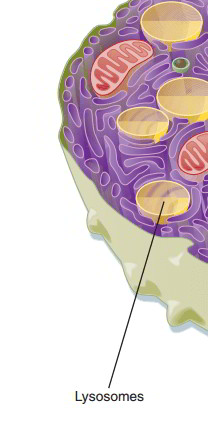Lysosomes are the membrane-bound vesicular organelles discovered throughout the cytoplasm. The lysosomes are formed by Golgi apparatus The enzymes manufactured in rough endoplasmic reticulum are processed and crammed in the form of little vesicles in the Golgi apparatus Then, these vesicles are pinched off from Golgi apparatus and end up being the lysosomes.
Amongst the organelles of the cytoplasm, the lysosomes have the thickest covering membrane. The membrane is formed by a bilayered lipid product. It has lots of little granules which include hydrolytic enzymes.
Types of Lysosomes
Lysosomes are of 2 types:
- Main lysosome, which is pinched off from Golgi apparatus It is inactive though it has hydrolytic enzymes
- Secondary lysosome, which is the active lysosome. It is formed by the combination of a main lysosome with phagosome or endosome.
Functions of Lysosomes
Lysosomes are typically called ‘ trash system’ of the cell since of their destruction activity. About 50 various hydrolytic enzymes, referred to as acid hydroxylases exist in the lysosomes, through which lysosomes perform their functions.
Crucial lysosomal enzymes
- Proteases, which hydrolyze the proteins into amino acids
- Lipases, which hydrolyze the lipids into fats and glycerides
- Amylases, which hydrolyze the polysaccharides into glucose
- Nucleases, which hydrolyze the nucleic acids into mononucleotides.
Mechanism of lysosomal function
Lysosomal functions include 2 mechanisms:
- Heterophagy: Digestion of extracellular products swallowed up by the cell through endocytosis
- Autophagy: Digestion of intracellular materials such as damaged cytoplasmic organelles.
Particular functions of lysosomes
- Destruction of macromolecules
Macromolecules are swallowed up by the cell by methods of endocytosis (phagocytosis, pinocytosis or receptor- moderated endocytosis). The macromolecules such as bacteria, swallowed up by the cell through phagocytosis are called phagosomes or vacuoles. The other macromolecules taken inside through pinocytosis or receptor-mediated endocytosis are called endosomes. The main lysosome merges with the phagosome or endosome to form the secondary lysosome. The pH in the secondary lysosome ends up being acidic and the lysosomal enzymes are triggered. The bacteria and the other macromolecules are absorbed and broken down by these enzymes. The secondary lysosome consisting of these broken down waste products moves through cytoplasm and merges with cell membrane. Now the waste products are gotten rid of by exocytosis.
- Destruction of damaged organelles
The rough endoplasmic reticulum covers itself around the damaged organelles like mitochondria and form the vacuoles called autophagosomes. One main lysosome merges with one autophagosome to form the secondary lysosome. The enzymes in the secondary lysosome are triggered. Now, these enzymes absorb the contents of autophagosome.
- Elimination of excess secretory products in the cells
Lysosomes in the cells of the secretory glands eliminate the excess secretory products by breaking down the secretory granules.
- Secretory function – secretory lysosomes
Just recently, lysosomes having actually secretory function called secretory lysosomes are discovered in a few of the cells, especially in the cells of immune system The traditional lysosomes are customized into secretory lysosomes by integrating with secretory granules (which include the secretory product of the cell).
Examples of secretory lysosomes:
- Lysosomes in the cytotoxic T lymphocytes and natural killer (NK) cells produce perforin and granzymes, which ruin both viral-infected cells and tumor cells Perforin is a pore-forming protein that starts cell death Granzymes come from the household of serine proteases (enzymes that remove the peptide bonds of the proteins) and trigger the cell death by apoptosis
- Secretory lysosomes of melanocytes produce melanin. Secretory lysosomes of mast cells produce serotonin, which is a vasoconstrictor substance and inflammatory arbitrator.


 (47 votes, average: 4.85 out of 5)
(47 votes, average: 4.85 out of 5)